Search Forum
Fuel Gauge Troubleshooting: 1985 5.0L EFI
Fuel Gauge Troubleshooting: 1985 5.0L EFI
|
Last winter it was noticed (suddenly) that both fuel gauges were reading Empty, or nearly so. Never had this problem before. Added several gallons of fuel back then but the needle didn’t seem to change, as I remember. In hind sight, pictures should have been taken to record the actual needle location for each tank but, alas, that wasn’t done.
Last week and this week, installed the new rear and midship tanks along with new Spectra fuel pump/sender units, verified resistance change with movement of the float sender. Added some fuel in the 5 (rear) to 8 (midship) gallon range in the tanks and there was barely any needle movement. In the midship tank the maximum needle movement was about a needle width above the E with about 8 gallons, on the E with ~6 gallons (picture). See pictures for current midship tank gauge readings: 0 gal left; ~6 gal right 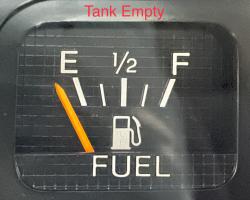 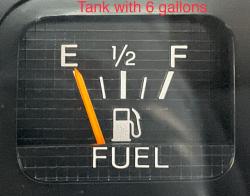 Due to reports of issues around the Tank Selector Valve the dash switch has not been moved any more than it has to, only to change from the Rear tank to the Midship tank to verify the Selector Valve works (can hear the Valve noise and by driving the rig with that setting for nearly 30 miles was verification enough that the Valve worked and the noise wasn’t a false noise). After doing research on this site last fall I found a diagram “104 ELEC. FUEL PUMP / TANK SELECTOR / GAUGES (dual tanks) 5.0L EFI “ wiring diagram but can’t re-find it. For info, it was noted back then that it was at Documentation>Electrical>EVTM/1985. Given that both gauges now appear to have the same defective reading issue, it appears from the schematic that the fault may be with the Tank Selector Valve Switch. The rational for this is that the Coolant Temperature and Oil Pressure gauges work fine and they are in the same Instrument Cluster as the Gas Gauge (on a circuit board). One other possibility is the problem can be with the circuit board or the wire between the Valve and the Fuel Gauge. Given the issues connected with the Valve, this makes it a plausible suspect. Maybe this is a sign of a future Valve failure? (I hope not!) Any ideas? If it is a in-the-dash suggestion that will probably be out of my capability. That place is a hard to get at jungle. Frankly, the Valve is in a fairly difficult to access place too.
-= John =- 1985 F-150 EFI 302/5.0L dual tanks, long-wide bed, "heavy-half"
|
|
i know this is basic but verify all grounds before digging too deep. the guage reads voltage ( regulated ) through a variable resistor( in tank level sender) to ground ( the tank) but there is also a wire to chassis ground. i believe it terminates at a point behind the radio towards the heater box but in the steel skeleton frame of the dashboard. any and all bolts connecting the dash to the cab are also considered grounds. any missing or rusted bolts should be treated as such.
|
Re: Fuel Gauge Troubleshooting: 1985 5.0L EFI
|
Administrator
|
In reply to this post by Nemesis F150
Probably this??
(It is from the 1986 EVTM) 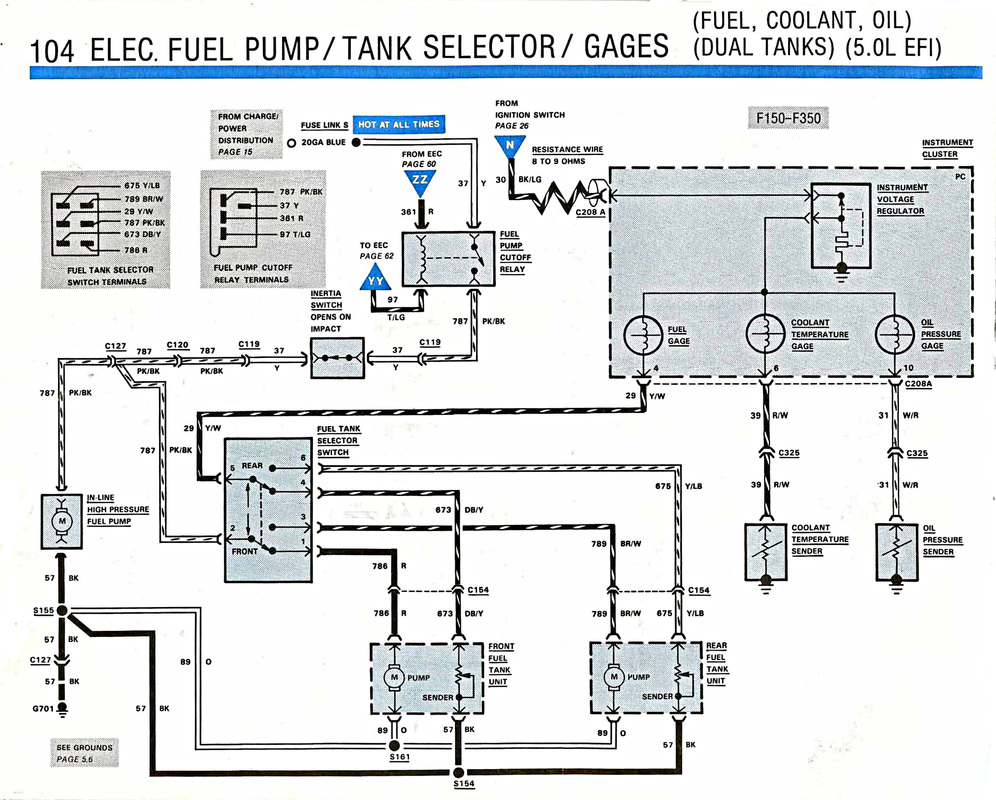
Jim,
Lil'Red is a '87 F250 HD, 4.10's, 1356 4x4, Zf-5, 3G, PMGR, Saginaw PS, desmogged with a Holley 80508 and Performer intake. Too much other stuff to mention. |
|
I am playing catch up on older posts.
So what is the problem as I dont under stand what it is? You checked the needles with no gas in the tanks and they were below the E line. Then you added 5 to 8 gallons to each tank and the needles moved up to the E line. So what is wrong? When the needles are on the line for E you have a reserve of 5 gallons if I under stand it right. I did the same thing on my truck, no gas in tanks needles below the E line. 5 gallons in each tank and the needles come up to the line. So when the needles hit the line I got 5 gallons left in each tank. I run off the front tank first and may run it down to the line but the rear tank I dont go that low just in case I cant get to a station. BTW with the tanks full the needles are above the F line and I dont care where the needles rear full but do when it get close to empty. Dave ----
Dave G.
81 F100 flare side 300 six / AA OD / NP435 / 2.75 gear http://cars.grantskingdom1.com/index.php/1980-Ford-F100?page=1 81 F100 style side 300 six/SROD parts truck -RIP http://cars.grantskingdom1.com/index.php/1981-Ford-F100 |
Re: Fuel Gauge Troubleshooting: 1985 5.0L EFI
|
In reply to this post by ArdWrknTrk
Dave - thanks for checking back and your post.
So, what is the problem? The (first) problem was with the first post. The gauges just weren’t moving as they should (or so I thought they should), and who want’s a gauge that isn’t telling the driver what is actually in the tank? As life would have it, things are really busy here with new crisis popping up almost daily, some benign, some pressing. Some weather dependent and with the days getting shorter, colder, and wetter, some project priorities get shifted. The gauge issue is an indoor project and the rig is not a daily driver, so priority-wise it kept slipping. And that was just one part. Not only that, but the gauge project started to mushroom. Mat’s comment about doing a ground check was a good one but, as they say, “easier said than done”. Started researching ground connections on the circuit diagrams and it became time consuming and mind boggling. There are a lot of ground connections … every wire carrying current has one! Had been meaning to write a post when your post showed up. Looking for an easier solution, decided to bite the bullet and fill up the Midship Tank. Lo and behold! The needle moved past the F (Full) mark! 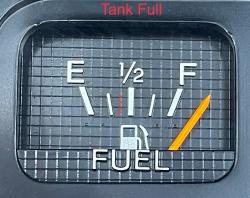 Not accustomed to a gas gauge being that far off in both directions. Wonder now if one can put a Potentiometer in the circuit and dial the gauge in so it is more accurate. Thank you for your gauge detail that led to a good solution. Oh, some trivia: cost to fill the Midship tank that already had some gas in it: $85.67. Note: Did not want to Fill the tank until the grounds were checked because it might have to be removed and that would have created a lot more work. Very glad that “problem” is solved now. Almost makes up for a new problem that just came up this afternoon (not vehicle related)!
-= John =- 1985 F-150 EFI 302/5.0L dual tanks, long-wide bed, "heavy-half"
|
Re: Fuel Gauge Troubleshooting: 1985 5.0L EFI
|
Administrator
|
John, Your problem is lower ohms is emptier.
If you add a resistor it will read higher, but you can't make full read lower. And you can't adjust one reading without effecting the whole range. If you want the empty tank at E and the full tank at F, you need something more than a resistor. Gary and I both use the MeterMatch from TechnoVersions to adapt senders that read backwards to our instruments. Not cheap, but they do work. From the above diagram we know the fuel gauges ground at G701. 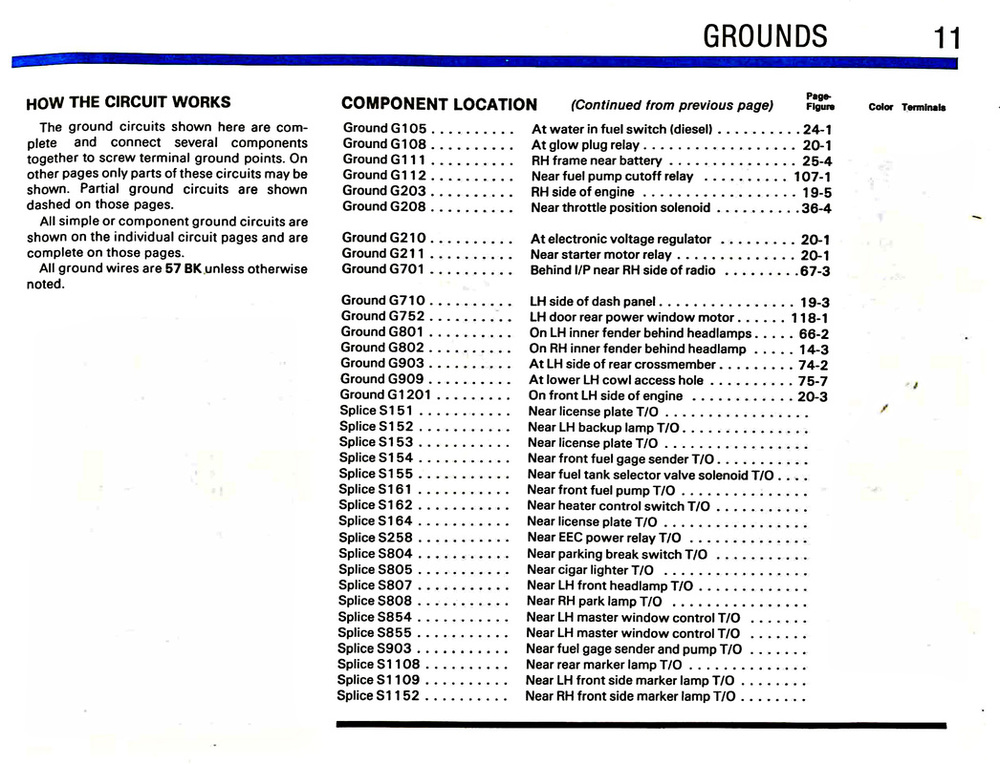 G701 is shown on pg. 67 diagram 3 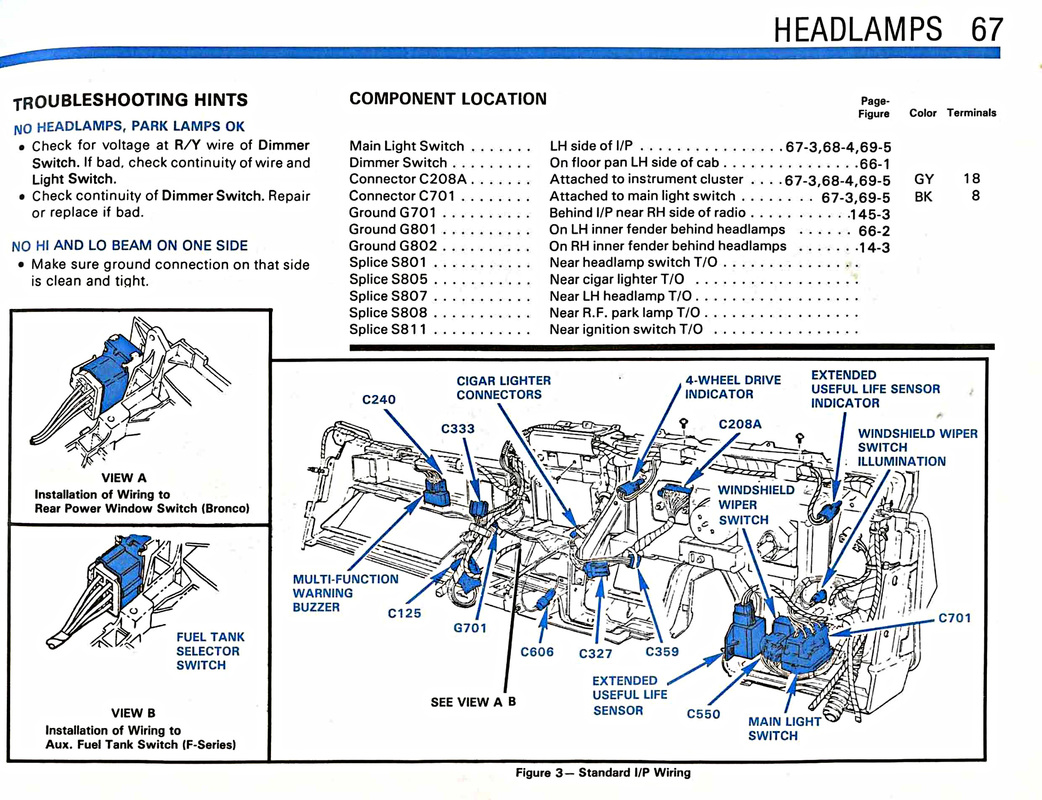 You can see it above the black words "SEE VIEW A B"
Jim,
Lil'Red is a '87 F250 HD, 4.10's, 1356 4x4, Zf-5, 3G, PMGR, Saginaw PS, desmogged with a Holley 80508 and Performer intake. Too much other stuff to mention. |
Re: Fuel Gauge Troubleshooting: 1985 5.0L EFI
|
Jim - really good post with regard to ground locations! A real keeper!
At this point there is no time to deal with tweaking the Fuel Gauges so will leave as is, and save the thread link. The plan now is to use the fuel down to the 1/4 tank mark then gradually fill the tank, make note of how many gallons go in at the 1/4 > 1/2, 1/2 > 3/4, Full, and “Really Full”. Might even start at E > 1/4 but don’t know if I can cover that many miles before the weather gets worse. Looking back, should have done this before filling the tank yesterday. Thanks a bunch for the concise post and the references! This whole thread, as short as it is, will be a useful keeper. Great, nah, The Best web site!
-= John =- 1985 F-150 EFI 302/5.0L dual tanks, long-wide bed, "heavy-half"
|
Re: Fuel Gauge Troubleshooting: 1985 5.0L EFI
|
Administrator
|
I'm glad I could be helpful
Hope you are able to resolve your fuel gauge issue
Jim,
Lil'Red is a '87 F250 HD, 4.10's, 1356 4x4, Zf-5, 3G, PMGR, Saginaw PS, desmogged with a Holley 80508 and Performer intake. Too much other stuff to mention. |
|
In reply to this post by Nemesis F150
this may just be one of those things that is best adjusted between the ears. these trucks and their guages are not really "lab quality " specific. i know that we all can get spoiled with the newer cars. my expedition tells me mpg. in real time or as an average. miles left in the tank etc. you may drive yourself batty trying to get these early "electronics" to your liking or you may just learn the old school charm of grand dads truck and enjoy. my truck only has the one tank and its the small one. no range to brag about but it matches the bladder.

|
Re: Fuel Gauge Troubleshooting: 1985 5.0L EFI
|
Just wanted to touch base again ... Filled up our 2009 Ford Escape and noticed that the gauge read exactly Full when it was full. Also, and interesting note: the fuel gauge dial almost has the same swing angle from F > E on the Escape as on the F-150.
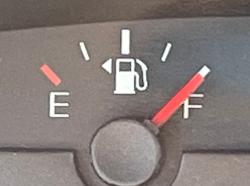 Have not checked out what the Escape gauge shows at empty (and don't want to) but planned to take a picture of it as it was around the 1/4-tank reading just to find out how many gallons would be there, to see if the gauge was liner or non-linear. Based on a 1,034.8 miles and three tank fills, where the starting tank fill and the ending tank fill was as close to exactly the same (filling it up to near the neck), it took 30.368 gallons. Calculating, that is 34.08 mpg and at the local price works out to ~ 14¢/mile. Planning to do something similar with the pickup but probably won't happen this year because I don't drive it that much. Based on what others have reported for their rigs, maybe I don't want to find out! (Don't ask the question if you don't want to hear the answer).
-= John =- 1985 F-150 EFI 302/5.0L dual tanks, long-wide bed, "heavy-half"
|
|
i like the thought process even though you may still be comparing apples to bananas
|
Re: Fuel Gauge Troubleshooting: 1985 5.0L EFI
|
The main reason I posted about the Escape fuel gauge was becasue it was very similar to the one in the 150. The Escape needle swing is within a few degrees of that on the 150. While there are many years between the two vehicles, sometimes parts don’t change that much between models, and sometimes parts change within a model year. The thought was about how one could re-purpose the guts of the Escape gauge into the 150. Just a thought.
A little background: as a kid, we lived in a neighborhood that had an abandoned auto wrecking yard nearby. This was after WWII and there were lots of, by today’s standards, very old vehicles (almost all were pre-war, some even pre WWI). There were interesting things for kids to take apart, like instrument gauges, gas gauges being one of them because they had small coils of very fine copper wire. The gauges were individual self-contained vice todays 1985 printed circuit types. Now, still thinking …. What if one could cannibalize the part of the Escape instrument printed circuit that controls the gauge then apply that to the 150 panel with some possible tweaks in the circuit to work with the tank sending unit? At this point I’m outa time…. Decided to just calibrate the existing gauge by keeping track of how many gallons are in the tank at the various quarter-fill marks then note where the 100% full and Empty needle locations are then call it good. With two tanks the hope is to keep the engine running when the tank empties then just switch tanks. Done this before (switching tanks, long time ago) and that much works. Going forward, noting the gallons at various key pints will be good enough. Have a lot of other things with higher priority to work on, one of which, at the moment, is what fuel additive(s) for low vehicle use during the winter months.
-= John =- 1985 F-150 EFI 302/5.0L dual tanks, long-wide bed, "heavy-half"
|
Re: Fuel Gauge Troubleshooting: 1985 5.0L EFI
|
Administrator
|
I got lost in this process as it appeared the gauge wasn't working with either tank, but I think you are now saying that it is but isn't calibrated correctly. So let me explain how the gauge works and suggest a couple of possible solutions.
First the fuel level, coolant temp, and oil pressure gauges for the Bullnose trucks are thermometers. Yep. There's a heating coil in the gauge that is right below a bi-metal spring that is wrapped around the shaft of the gauge, and as the temp goes higher so does the gauge. And the heat is generated by the current going though the sending unit - more current means more heat. But the gauges were designed for a 6V system, and when the industry changed to 12V Ford just reduced the voltage to the gauges. However, they did it with a device that is called the Instrument Cluster Voltage Regulator (ICVR), which is really only a chopper - the voltage sent to the sending unit and thence to the gauge is a series of spikes, and the average of the spikes over time gets the wattage down to what it would have been with a 6V system. But the ICVR's are known to fail or go wonky. And that changes the reading of all three gauges, but since the fuel gauge is the only one that usually goes to full scale, that's the one that is the most impacted. So here are my suggestions: Test: The way to test if your system is working is to ground the wire to the sending units. (Plural as you can do this for both tanks and for the coolant and oil pressure sending units.) The gauge should swing to full scale and probably more pretty quickly, so don't leave it grounded for a long time.ICVR: If the gauges don't go to full scale then replace the ICVR with a true voltage regulator. We have a how-to at Documentation/Electrical/ICVR, but some of the vendors are now selling a plug-and-play unit. If you go with the adjustable regulator you can fill one tank FULL and tweak the voltage so it reads right on Full.MeterMatch: If you find that you still can't get the fuel gauge to read how you want it to read then consider a MeterMatch. Jim and I are using them to interface the later sending units, whose resistance ranges are backwards awa different to the Bullnose units, to the Bullnose gauges. But they can be used to simply calibrate a gauge as you can use them to calibrate Empty, Full, and two other points in the range.
Gary, AKA "Gary fellow": Profile
Dad's: '81 F150 Ranger XLT 4x4: Down for restomod: Full-roller "stroked 351M" w/Trick Flow heads & intake, EEC-V SEFI/E4OD/3.50 gears w/Kevlar clutches
|
Bullnose Enthusiasts Forum
|
1 view|%1 views
| Edit this page |

